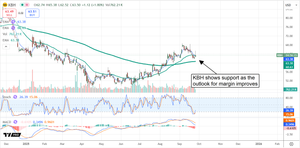
Gold prices have shattered all previous records, surging to an unprecedented high above US$3,700 per ounce, with December futures touching $3,795.90 per troy ounce. This historic rally is largely fueled by escalating market expectations that the U.S. Federal Reserve will continue its aggressive interest rate cutting cycle in the coming months, marking a significant shift in global financial markets.
The precious metal's ascent underscores a growing investor conviction that the era of higher interest rates is waning, paving the way for non-yielding assets like gold to shine. This development has profound implications for investment strategies, inflation hedges, and the broader economic outlook, signaling a potential recalibration of risk and value across various asset classes.
What Happened and Why It Matters
In a remarkable display of market strength, spot gold prices consistently hit fresh lifetime highs throughout September 2025, culminating in a peak near US$3,790.82 per ounce. This surge follows the Federal Reserve's recent 25-basis point rate cut, its first reduction in nearly a year, which was interpreted by markets as a precursor to further monetary easing. The Fed's dovish pivot, driven by concerns over a softening labor market and employment risks, has ignited a powerful rally in gold, transforming it into a top-performing asset.
The underlying economic rationale is compelling. Gold, a non-yielding asset, becomes significantly more attractive when interest rates fall, as the opportunity cost of holding it decreases relative to interest-bearing assets like bonds. Furthermore, rate cuts typically weaken the U.S. dollar, making gold cheaper for international buyers and boosting demand. Historically, gold has also served as a reliable hedge against inflation, which can be a byproduct of aggressive monetary easing designed to stimulate economic growth. Amidst ongoing global economic uncertainties and geopolitical tensions, gold's traditional role as a safe-haven asset further enhances its appeal, drawing in investors seeking stability and wealth preservation.
Current market sentiment, as reflected by tools like the CME FedWatch, indicates a high probability of additional rate cuts by the Fed in October and December. Analysts from major financial institutions like Goldman Sachs are also projecting further easing, potentially even a 50 basis point reduction if the labor market deteriorates significantly. This collective expectation of a more accommodative monetary policy environment has created a powerful tailwind for gold, pushing it into uncharted territory and signaling a shift in investor confidence away from traditional interest-bearing instruments.
The Golden Tide: Market Winners and Losers
The unprecedented surge in gold prices is poised to create a distinct landscape of winners and losers across various market sectors. Companies directly involved in gold mining and precious metals are undoubtedly the primary beneficiaries, experiencing a significant boost to their profitability and stock valuations. Major gold miners like Newmont Corporation (NYSE: NEM), Barrick Gold (NYSE: GOLD), Agnico Eagle Mines (NYSE: AEM), AngloGold Ashanti (NYSE: AU), Gold Fields (NYSE: GFI), and Kinross Gold (NYSE: KGC) have already seen their share prices climb, with some reporting triple-digit gains this year. Their operational margins expand considerably as the value of their primary product escalates, leading to increased earnings and potential dividend payouts. Even companies like Freeport-McMoRan (NYSE: FCX), primarily known for copper but with significant gold operations like the Grasberg mine, stand to gain from this rising tide.
Beyond direct mining operations, precious metal investment vehicles are also experiencing heightened interest. Exchange-Traded Funds (ETFs) that hold physical gold, such as SPDR Gold Trust (GLD) and iShares Gold Trust (IAU), provide investors with liquid and accessible exposure to the gold rally. Similarly, ETFs focused on gold mining companies, like the VanEck Gold Miners ETF (GDX) and VanEck Junior Gold Miners ETF (GDXJ), are seeing substantial inflows. These instruments offer diversified ways for investors to capitalize on the upward trajectory of gold prices without direct physical ownership or individual stock selection.
Conversely, the sustained strength in gold, driven by expectations of lower interest rates and potentially higher inflation, could pose challenges for certain market segments. Sectors that thrive on a strong dollar or stable, higher interest rates, such as some financial institutions or certain fixed-income investments, might face headwinds. If the Fed's easing cycle leads to persistent inflationary pressures, it could erode the purchasing power of cash and fixed-income returns, making gold a more attractive alternative for wealth preservation. However, the broader market impact depends heavily on the pace and extent of future rate cuts and the overall health of the global economy.
Broader Implications and Historical Parallels
The current gold rally is not merely a fleeting market phenomenon; it represents a significant shift in investor psychology and broader economic trends. This event fits into a historical pattern where gold often thrives during periods of monetary easing and economic uncertainty. Looking back, gold prices surged by 31% after Fed rate cuts in 2000, 39% during the 2007-2008 financial crisis, and approximately 25-26% during the easing cycles of 2019 and 2019-2020. These historical precedents underscore gold's enduring role as a hedge against systemic risk and a beneficiary of accommodative monetary policies.
The ripple effects of sustained high gold prices extend beyond direct investors. Central banks globally have been net buyers of gold for years, diversifying their reserves and hedging against currency fluctuations. A rising gold price strengthens their balance sheets and provides an additional layer of financial stability. This trend could intensify, further underpinning gold's demand. Moreover, the increased profitability of mining companies could lead to greater capital expenditure in exploration and development, potentially boosting employment in mining regions and supporting related industries that supply equipment and services.
Regulatory and policy implications also warrant attention. If the Fed's aggressive rate cuts are seen as a response to deeper economic vulnerabilities, it could prompt policymakers to consider additional fiscal stimulus or structural reforms to support growth and employment. The interplay between monetary policy, inflation, and commodity prices will remain a critical focus for global financial institutions and governments alike, shaping future economic strategies and risk management frameworks.
What to Pay Attention to Next
As gold basks in its record-breaking glory, investors and market observers should keenly watch several key indicators for insights into its future trajectory. The most immediate focus will be on upcoming Federal Reserve meetings and any forward guidance from Chairman Jerome Powell regarding the pace and magnitude of future interest rate cuts. Any deviation from the market's current dovish expectations, or stronger-than-anticipated economic data, could introduce volatility. Conversely, continued signs of a weakening labor market or persistent inflation concerns could further entrench the Fed's easing stance, providing additional impetus for gold.
Beyond monetary policy, geopolitical developments and global economic stability will continue to play a crucial role. Escalations in international conflicts, trade tensions, or significant economic slowdowns in major economies could reinforce gold's safe-haven appeal. Investors should also monitor the U.S. dollar's performance; a continued weakening trend would be supportive of gold, while a rebound could temper its ascent.
For specific market opportunities, attention should remain on the earnings reports and production guidance of major gold mining companies. Strong operational performance coupled with high gold prices could lead to significant shareholder returns. Additionally, the performance of gold-backed ETFs and other precious metal investment products will serve as a barometer for broader investor sentiment towards the asset class. Potential scenarios range from a continued, steady appreciation driven by sustained Fed easing to more volatile swings if economic data or policy signals become mixed.
Conclusion
Gold's surge to a record high, propelled by the strong anticipation of further Federal Reserve interest rate cuts, marks a pivotal moment in financial markets. This rally underscores the enduring relationship between monetary policy, inflation concerns, and the intrinsic value of precious metals as a store of wealth and a hedge against economic uncertainty. The immediate implications are clear: gold miners and related investment vehicles are experiencing a boom, while the broader market recalibrates to a potentially lower interest rate environment.
Moving forward, the trajectory of gold will largely hinge on the Federal Reserve's actions and global economic stability. Investors should closely monitor Fed communications, inflation data, and geopolitical events. The current environment presents both opportunities and challenges, with gold offering a potential haven for those seeking to preserve capital amidst economic shifts. Its role as a safe asset and inflation hedge appears more relevant than ever, making it a critical component of diversified portfolios in the coming months.
This content is intended for informational purposes only and is not financial advice.





